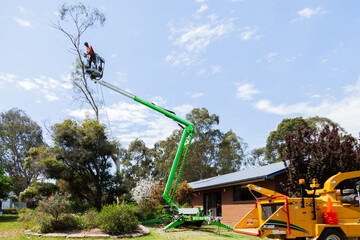A well-maintained lawn and healthy trees are the foundation of a beautiful outdoor space. Proper lawn and tree care not only enhances curb appeal but also contributes to a safer, more enjoyable environment. From regular mowing and fertilization to pruning and disease prevention, understanding the essential aspects of lawn and tree care ensures that your outdoor space thrives year-round.

Why Lawn and Tree Care Is Important
Maintaining a healthy lawn and strong trees goes beyond aesthetics. Lawns provide soft, safe surfaces for recreational activities and help reduce soil erosion, while trees improve air quality, provide shade, and create natural windbreaks. Neglecting lawn and tree care can lead to overgrowth, pest infestations, diseases, and weakened root systems, which can result in costly repairs or replacements.
A vibrant lawn and healthy trees also boost property value and create a welcoming environment for visitors. Investing in proper care practices ensures a long-lasting, sustainable landscape that benefits both your property and the surrounding ecosystem.
Essential Lawn Care Practices
- Mowing and Trimming: Regular mowing is crucial for maintaining a healthy lawn. Cutting grass at the proper height encourages strong root growth, prevents weed invasion, and improves overall lawn density. Trimming around trees, garden beds, and pathways helps maintain a neat, well-groomed appearance.
- Fertilization: Fertilizing your lawn provides essential nutrients that promote growth and resilience. A balanced fertilizer tailored to your grass type and climate supports root development, enhances color, and strengthens the lawn against stress from weather, pests, and disease.
- Watering: Consistent watering is vital for lawn health. Deep, infrequent watering encourages deep root growth, making grass more drought-resistant. Early morning watering reduces evaporation and prevents fungal growth, ensuring that your lawn receives the moisture it needs to thrive.
- Aeration and Overseeding: Lawn aeration relieves soil compaction, improves water and nutrient absorption, and encourages root development. Overseeding helps fill in thin areas, creating a lush, uniform lawn while reducing weed growth.
- Weed and Pest Control: Weeds compete with grass for nutrients and water, while pests can damage roots and foliage. Implementing an integrated approach that combines manual removal, organic treatments, and preventive measures keeps your lawn healthy and attractive.
Key Tree Care Practices
- Pruning and Trimming: Regular pruning removes dead or diseased branches, promotes healthy growth, and improves the tree’s shape. Proper trimming prevents branches from interfering with structures or creating hazards while allowing sunlight and air to reach the canopy.
- Watering and Mulching: Newly planted trees require consistent watering until their roots establish. Mulching around the base retains moisture, moderates soil temperature, and reduces weed growth, all of which support long-term tree health.
- Fertilization: Trees benefit from targeted fertilization, especially in nutrient-deficient soil. Providing the right nutrients encourages strong root systems, healthy foliage, and improved resistance to disease and environmental stress.
- Pest and Disease Management: Trees are susceptible to a variety of pests and diseases that can weaken or kill them. Early detection, proper treatment, and preventive care are essential to maintaining tree health. Integrated pest management strategies help minimize damage while protecting the environment.
- Structural Support and Protection: Young or newly transplanted trees may require staking or protective barriers to shield them from wind, animals, or accidental damage. Structural support ensures that trees develop strong trunks and root systems for long-term stability.
Seasonal Lawn and Tree Care Tips
Lawn and tree care practices should adapt to seasonal changes:
- Spring: Focus on fertilization, aeration, and pruning to prepare your lawn and trees for active growth. Remove debris and apply mulch to conserve moisture.
- Summer: Maintain consistent watering, monitor for pests, and trim overgrown branches. Apply preventive treatments for common seasonal diseases.
- Fall: Rake leaves, overseed thin areas, and apply fall fertilizers to strengthen grass roots. Prune trees to remove damaged or crossing branches.
- Winter: Protect young trees from frost and snow damage. Avoid heavy foot traffic on dormant lawns to prevent compaction and stress.
Eco-Friendly Lawn and Tree Care
Sustainable lawn and tree care practices benefit both your property and the environment. Using organic fertilizers, compost, and natural pest control reduces chemical runoff and soil contamination. Planting native trees and grass species minimizes water requirements and supports local wildlife. Additionally, mulching and rainwater harvesting help conserve resources while maintaining healthy landscapes.
Benefits of Professional Lawn and Tree Care
While routine maintenance can be performed by homeowners, professional lawn and tree care services provide expertise, equipment, and advanced techniques that ensure optimal results. Professionals can identify early signs of disease, select appropriate fertilizers, and implement preventive measures that protect your investment. Whether for residential properties or commercial spaces, expert care enhances the longevity and visual appeal of lawns and trees.
Lawn and tree care is essential for creating a vibrant, healthy, and visually appealing outdoor space. From regular mowing and fertilization to pruning, pest management, and seasonal maintenance, these practices ensure that your grass remains lush and your trees grow strong. Sustainable care methods enhance property value, promote environmental responsibility, and provide a safe, enjoyable landscape for everyone.
Investing time and effort into lawn and tree care pays off with beautiful, thriving outdoor areas that elevate the overall look and feel of your property. By adopting consistent maintenance practices and addressing issues promptly, you can enjoy a flourishing, resilient landscape that lasts for years to come.